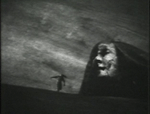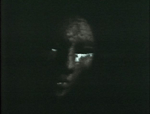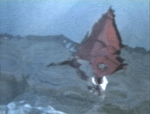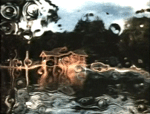L’Ange, 1982. Connected by the recurring image of floating, disarticulated staircases, Patrick Bokanowski’s equally transfixing, mysterious, and impenetrable magnum opus, L’Ange may be characterized as a synesthetic composition – a series of aesthetically distinctive, self-encapsulated chamber pieces, each revealing quotidian, if fantastic, acts of obsessive compulsion and moribund ritual. Converging towards the hybrid animation of his early short films, La Femme qui se poudre and Déjeuner du matin, Bokanowski’s curious, often gothic figurations reveal an abstract logic of thematic suites that similarly reveal his penchant for juxtaposing optical experimentation with traditional fine arts, where rended objects (a doll used as a fencing target in L’Homme au sabre), accidental ruptures (a pitcher falls from the dinner table in L’Homme sans mains), and bursts of activity (a bather splashes animatedly in L’Homme au bain, and a group of identical librarians research, file, and reorganize a sprawling library in Les Bibliothécaires) reflect an overarching, universal law of entropy that, paradoxically, enables creation from the very act of friction, disorder, kinesis, and destruction.
Reflecting the seemingly hermetic nature of the individual vignettes through the characters’ isolation (reinforced by the dimmed, directional lighting that suffuses the film), Bokanowski, nevertheless, integrally links each episode to the other through modulated visual semblances and recurring images of graduated steps and staircases that bind the assorted leitmotifs together towards an implied vertical movement. At the core of the film’s arrangement is a Dante Alighieri-esque (upended) evolution from darkness to light, a conceptual progression that Bokanowski describes as a physical transition through interrelated spaces during his interview with Scott MacDonald for Critical Cinema 3: Interviews with Independent Filmmakers:
About the overall structure of The Angel, I can say that it is very traditional. You have a staircase, you go from the cellar to the attic. Scenes start falling into place during the dark, shapeless, not very precise starting phase; and then the more the film progresses, the more precise things become, and at the end, it reveals extremely luminous areas.
In one of the earliest stages, when I was doing the scenario, I thought that when one comes to the far top of this gigantic house, to an attic room, a last character would appear, some kind of a giant with barely discernible wings, some kind of angelic figure. He would lift the arm of the phonograph, the music would stop, and one would see all the film’s scenes in still frames. Very quickly, I disliked the character. He was impossible to film! So, I did not keep this sequence, but that character did give the film its title.
It is interesting to note that despite Bokanowski’s strategy to reject the inclusion of a unifying, iconic, titular image, the idea of an underlying celestial entity continues to pervade the film’s visual composition through the application of point source lighting, the aforementioned luminosity, that, through light’s integral optical properties of diffusion and diffraction, results in the formation of recursive, concentric rays that project a sunburst or halo effect throughout the film – at times, exaggerated and grotesque (as in the expressionistic, elongated, web-like abstract forms of the opening sequence), warm and pastoral (as in the image of a Flemish painting-styled milkmaid serving “the man without hands”), and saturated and disorienting (as in the frenetic, decontextualized, rapidly edited montage of the seemingly subterranean activities (or perhaps imprisonment) of La Femme qui coud).
Particularly illustrative of Bokanowski’s aesthetic is the malleability and relativity of dimensional space: blocky, rough hewn lines that resemble woodcut prints are unsuspectingly animated by the initiation of transversal motion (in the sequence of a turbaned operator of a sextant-like instrument facing a seated, veiled figure), extreme long shots blur the delineation between live action and animation sequences (in the interstitial sequence of the liberated librarians encountering a woman in a boxed enclosure), and painterly images transformed into virtual tableaux vivants (in the Vermeer-inspired, L’Homme sans mains). Subverting the flatness of images in order to continually challenge the viewer’s spatial and cognitive perception, L’Ange not only illustrates the intrinsic hybridity of film as a static and dynamic medium, but also reinforces the ambiguity and inconcreteness implicit in the aesthetic presentation of the very images themselves, where chaos transforms into order, frailty into perfection, and quotidian into grace.
Patrick Bokanowski: Short Films (1972-1994)
My first exposure to French filmmaker Patrick Bokanowski’s experimental cinema was with his transfixing, yet vague and impenetrable magnum opus L’Ange, a Dante Alighieri-esque depiction of intranscendence and moribund ritual that would ingrain the (somewhat reductive) idea that his films were abstract visual studies in structuralism, modulation, and repetition. In hindsight, underneath this cursory first impression of Bokanowski’s aesthetic is an intrinsic aspect of his filmmaking that is undeniably artful and innovative – particularly within the context of his short films – and that, like Oskar Fischinger’s deconstructed, aural waveforms, approach a synesthetic convergence between image and sound. In his optical experiments with light, reflection, and refraction that transform everyday images into fluid and deformable art objects that redefine the medium of film as a traditional canvas, Bokanowski shares a visual affinity with Aleksandr Sokurov’s murky and expressionistic in-line optical distortions in films such as Mother and Son and Oriental Elegy that, like the works of aesthetic forefathers such as Pieter Brueghel the Elder and Caspar David Friedrich, evoke the primal, transmogrified spiritual landscapes that haunt our consciousness and give form to our waking dreams.
 La Femme qui se poudre, 1972. Something of a hybrid between Jean Cocteau and Jan Svankmajer in its gothic expressionism and artful grotesquerie crossed with the metric precision of Kurt Kren’s more clinical materialaktion films that experiment with the plasticity of surfaces (most notably, in the deformed figures that recall the disfiguration and self-mutilation of Kren’s short film, 10/65 Selbstverstümmelung), Bokanowski’s earliest film, La Femme qui se poudre (The Woman Who Powders Herself) is, as the title implies, an evocation of concealment and unmasking, where the mundane act of a Victorian-era woman’s ritualistic application of cosmetic powder seemingly opens the window – or perhaps, Pandora’s Box – into underlying human anxieties of physical beauty, youth, desirability, and objectification. Reflecting the superficiality of societal notions of beauty through the alienness of landscape and the ephemeral riddle of true identity through epic, soul-searching journeys and faceless phantoms that emerge from thin air before vanishing from view, the terrifying images break apart and eventually disintegrate into irresolvable fragments of haunted memory within the course of the increasingly abstract film, as the waking dream descends ever further into the realm of nightmare and the deepest recesses of the subconscious, unraveling the veil of human vanity to reveal amorphous shadows cast by empty souls.
La Femme qui se poudre, 1972. Something of a hybrid between Jean Cocteau and Jan Svankmajer in its gothic expressionism and artful grotesquerie crossed with the metric precision of Kurt Kren’s more clinical materialaktion films that experiment with the plasticity of surfaces (most notably, in the deformed figures that recall the disfiguration and self-mutilation of Kren’s short film, 10/65 Selbstverstümmelung), Bokanowski’s earliest film, La Femme qui se poudre (The Woman Who Powders Herself) is, as the title implies, an evocation of concealment and unmasking, where the mundane act of a Victorian-era woman’s ritualistic application of cosmetic powder seemingly opens the window – or perhaps, Pandora’s Box – into underlying human anxieties of physical beauty, youth, desirability, and objectification. Reflecting the superficiality of societal notions of beauty through the alienness of landscape and the ephemeral riddle of true identity through epic, soul-searching journeys and faceless phantoms that emerge from thin air before vanishing from view, the terrifying images break apart and eventually disintegrate into irresolvable fragments of haunted memory within the course of the increasingly abstract film, as the waking dream descends ever further into the realm of nightmare and the deepest recesses of the subconscious, unraveling the veil of human vanity to reveal amorphous shadows cast by empty souls.
 Déjeuner du matin, 1974. Incorporating painterly, Friedrich-like rural landscapes (that prefigure the profoundly isolated, psychological landscape of Sokurov’s Mother and Son) set against expressionistic images of elongated shadows, skeletal structures, and highly acute camera angles that distort perspective fields of view, Déjeuner du matin subverts conventional notions of family and domestic ritual to create a haunted portrait of isolation and Sisyphean ritual. Bokanowski sets the tedium of mundane, near-autonomic morning routines on a provincial farmhouse (a looped sequence depicting an inventor drafting his latest design at the break of dawn reinforces this sense of somnambulism) – eating breakfast, shaving, carrying bales of hay – against a sense of claustrophobic inescapability where momentary eruptions of unprovoked domestic violence are attenuated within the oscillations of a lifeline, and even the act of flight through the hills in order to watch the sun rise is made ominous by the churning of the clouds, the fragile balance of near-collapsing structures, and the silence of inorganic, forbidding mountains. Concluding with petrified images of despair and inanimate, seemingly truncated attempt at connection (or perhaps, reconciliation), the tonally jarring incorporation of a melodic, carnivalesque arcade music serves as a wry reinforcement of the theme of eternal cycles of ritual.
Déjeuner du matin, 1974. Incorporating painterly, Friedrich-like rural landscapes (that prefigure the profoundly isolated, psychological landscape of Sokurov’s Mother and Son) set against expressionistic images of elongated shadows, skeletal structures, and highly acute camera angles that distort perspective fields of view, Déjeuner du matin subverts conventional notions of family and domestic ritual to create a haunted portrait of isolation and Sisyphean ritual. Bokanowski sets the tedium of mundane, near-autonomic morning routines on a provincial farmhouse (a looped sequence depicting an inventor drafting his latest design at the break of dawn reinforces this sense of somnambulism) – eating breakfast, shaving, carrying bales of hay – against a sense of claustrophobic inescapability where momentary eruptions of unprovoked domestic violence are attenuated within the oscillations of a lifeline, and even the act of flight through the hills in order to watch the sun rise is made ominous by the churning of the clouds, the fragile balance of near-collapsing structures, and the silence of inorganic, forbidding mountains. Concluding with petrified images of despair and inanimate, seemingly truncated attempt at connection (or perhaps, reconciliation), the tonally jarring incorporation of a melodic, carnivalesque arcade music serves as a wry reinforcement of the theme of eternal cycles of ritual.
 La Plage, 1992. Composed of four chapters depicting optical modulations of scenes from a day at the beach, La Plage illustrates Bokanowski’s continued fascination (and experimentation) with the chromic, refractive, and reflective properties of glass to create films that redefine the materiality of celluloid and explore the plasticity of surfaces to transform everyday objects into works of art. The high contrast, blue tinting of the first chapter prefigures the opening sequence of Dolce in its evocation of nocturnal tempest (and perhaps even a glimpse of the forking of waters in Sharunas Bartas’ Few of Us). The second chapter forgoes the darker chromic filters while retaining the film’s high contrast to create a sense of floating otherworldliness to the images, an atmosphere that is further emphasized through a shift in camera framing from people anchored on the foreground (generally near the bottom) of the frame in the previous chapter, to people framed in the middle of the shot, seemingly suspended in the enveloping water between the terrestrial and the celestial. The third chapter introduces variable density optics (where the multiple indices of refraction reside at various sectors within the same lens) into the camera’s line of sight that refract light into visually unexpected transmittive or reflective angles such that organic shapes become angular and compartmentalized into cubist-like organic geometries, and monolithic forms take on an appearance of fluidity and motion. Creating nodal point images that present a differential mapping of “concentrations of matter”, Bokanowski cleverly redefines notions of visibility into relativistic realms of motion and inertia. Lastly, the fourth chapter returns to the chromic filters of earliest chapters. Concluding with a frozen image of a woman and child gazing out to sea that is framed against the warm, red and amber hues of a seeming sunset, the parting shot becomes a reinforcing image of return to innocence and the beauty of simplicity.
La Plage, 1992. Composed of four chapters depicting optical modulations of scenes from a day at the beach, La Plage illustrates Bokanowski’s continued fascination (and experimentation) with the chromic, refractive, and reflective properties of glass to create films that redefine the materiality of celluloid and explore the plasticity of surfaces to transform everyday objects into works of art. The high contrast, blue tinting of the first chapter prefigures the opening sequence of Dolce in its evocation of nocturnal tempest (and perhaps even a glimpse of the forking of waters in Sharunas Bartas’ Few of Us). The second chapter forgoes the darker chromic filters while retaining the film’s high contrast to create a sense of floating otherworldliness to the images, an atmosphere that is further emphasized through a shift in camera framing from people anchored on the foreground (generally near the bottom) of the frame in the previous chapter, to people framed in the middle of the shot, seemingly suspended in the enveloping water between the terrestrial and the celestial. The third chapter introduces variable density optics (where the multiple indices of refraction reside at various sectors within the same lens) into the camera’s line of sight that refract light into visually unexpected transmittive or reflective angles such that organic shapes become angular and compartmentalized into cubist-like organic geometries, and monolithic forms take on an appearance of fluidity and motion. Creating nodal point images that present a differential mapping of “concentrations of matter”, Bokanowski cleverly redefines notions of visibility into relativistic realms of motion and inertia. Lastly, the fourth chapter returns to the chromic filters of earliest chapters. Concluding with a frozen image of a woman and child gazing out to sea that is framed against the warm, red and amber hues of a seeming sunset, the parting shot becomes a reinforcing image of return to innocence and the beauty of simplicity.
 Au bord du lac, 1994. Bokanowski returns to the complex – and mind-bending – optical array of pinholes, mirrors, prisms, and refractive substrates of his earlier film, La Plage to create the whimsical and playful Au bord du lac. The film is composed of mundane, everyday scenes of recreation and leisure on an idyllic, sunny day at a park that overlooks a lake – rowing a boat, playing a game of volleyball, rollerskating, bicycling, reading a newspaper, sunbathing, riding on horseback, or strolling on the promenade – shot through optical distortions to create fractured and knotted images that resemble embellished, gothic fairytale illustrations or appear to resolve into morphing, geometric patterns of fluid motion. Evoking the vibrant colors and sun-soaked palette of an invigorated Vincent van Gogh in Arles, Bokanowski transforms the quotidian into an infinitely mesmerizing dynamic kaleidoscope of shape-shifting textures and self-reconstituting objects of organic, abstract art.
Au bord du lac, 1994. Bokanowski returns to the complex – and mind-bending – optical array of pinholes, mirrors, prisms, and refractive substrates of his earlier film, La Plage to create the whimsical and playful Au bord du lac. The film is composed of mundane, everyday scenes of recreation and leisure on an idyllic, sunny day at a park that overlooks a lake – rowing a boat, playing a game of volleyball, rollerskating, bicycling, reading a newspaper, sunbathing, riding on horseback, or strolling on the promenade – shot through optical distortions to create fractured and knotted images that resemble embellished, gothic fairytale illustrations or appear to resolve into morphing, geometric patterns of fluid motion. Evoking the vibrant colors and sun-soaked palette of an invigorated Vincent van Gogh in Arles, Bokanowski transforms the quotidian into an infinitely mesmerizing dynamic kaleidoscope of shape-shifting textures and self-reconstituting objects of organic, abstract art.
Acquarello 2006 [reprinted]
